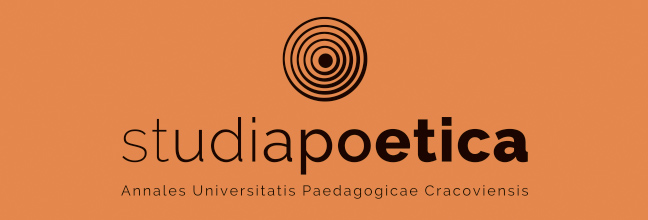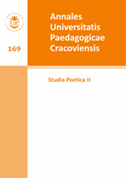Wirtualna semantyka miasta
Main Article Content
Abstrakt
Vitrual semantics of city
In the era of information revolution we are communicating via the web. Reflections, thoughts and information are transmitted by building up the language of augmented reality. In communication networks, while leading a chat, we are also influenced by advertisements. It is a kind of multiple contact with the network of friends, strangers, journalists and advertising agents. Symbols and patterns transmitted by tradition are given their virtual dimension, their universal archetypes adjust their character to the present. The Modern Man, a network user, tries to use the new tool - the computer - more efficiently. The Internet network is often compared to the extension of the human neural system. The computer as a medium of art was used to create an additional space - the virtual reality. It showed how interesting spaces can be created by combining art and technology. The combination of the human specificity of contact, language, and new technology creates tremendous opportunities and threats. Transhumanism is a possibility in which we would seek a symbiosis between the man and technology, so as not to create a conflict between the biological body and its electronic contact networks. The semantics of the city, despite of its changing nature, may have human-specific qualities, but its media expression may allow for incomparably richer network of contacts.
Downloads
Article Details
Wydawca „Annales Universitatis Paedagogicae Cracoviensis. Studia Poetica” jest upoważniony do korzystania oraz do rozpowszechniana wszystkich opublikowanych w czasopiśmie materiałów na podstawie umowy licencji niewyłącznej nieograniczonej w czasie - zawartej uprzednio na czas nieoznaczony każdorazowo z autorem/ką konkretnego utworu na określonych w tamtejszej umowie polach eksploatacji.
POLITYKA OTWARTEGO DOSTĘPU
„Annales Universitatis Paedagogicae Cracoviensis. Studia Poetica” to czasopismo o otwartym dostępie, a cała jego zawartość jest dostępna bezpłatnie dla użytkowników i instytucji na zasadach Creative Commons Attribution CC-BY 4.0. (uznanie autorstwa). Użytkownicy/ki mogą czytać, pobierać, wykonywać kopie, rozpowszechniać, drukować, wyszukiwać lub linkować do pełnych tekstów artykułów w tym czasopiśmie bez uprzedniej zgody wydawcy lub autora/ki pod warunkiem podania źródła dostępu i autorstwa danej publikacji. Jest to zgodne z definicją otwartego dostępu BOAI (http://www.soros.org/openaccess).
Bibliografia
Ascott R., Telenoia, [in:] R. Ascott, Telematic Embrace, Berkeley 2007.
##plugins.generic.googleScholarLinks.settings.viewInGS##
Ascott R., The Ambiguity of Self: Living in a Variable Reality, [in:] New Realities: Being Syncretic, ed. R. Ascott, G. Bast, W. Fiel, Vienna 2009.
##plugins.generic.googleScholarLinks.settings.viewInGS##
Baudrillard J., Symulakry i symulacja, tłum. S. Królak, Warszawa 2005.
##plugins.generic.googleScholarLinks.settings.viewInGS##
Bauman Z., Globalizacja, Warszawa 2000.
##plugins.generic.googleScholarLinks.settings.viewInGS##
Benjamin W., Twórca jako wytwórca, wyb. H. Orłowski, tłum. H. Orłowski, J. Sikorski, Poznań 1975.
##plugins.generic.googleScholarLinks.settings.viewInGS##
Benjamin W., Zapiski i materiały, [w:] W. Benjamin, Pasaże, tłum. I. Kania, Kraków 2005.
##plugins.generic.googleScholarLinks.settings.viewInGS##
Boellstorff T., Dojrzewanie w Second Life, tłum. A. Sadza, Kraków 2012.
##plugins.generic.googleScholarLinks.settings.viewInGS##
Eco U., Interpretacje i nadinterpretacje, tłum. T. Biedroń, Kraków 1994.
##plugins.generic.googleScholarLinks.settings.viewInGS##
Fleischmann M., W. Strauss, Performing Data, tłum. A. Brzezińska, Gdańsk 2011.
##plugins.generic.googleScholarLinks.settings.viewInGS##
Holloway-Attaway L., Mapowanie mobilności – interfejs i ślad po człowieku, [w:] W stronę trzeciej kultury, red. R. Kluszczyński, Gdańsk 2011.
##plugins.generic.googleScholarLinks.settings.viewInGS##
Jelewska A., Sensorium i spekulatywne symbiotyczne formy komunikacji, Poznań 2012.
##plugins.generic.googleScholarLinks.settings.viewInGS##
Kluszczyński R., Sztuka interaktywna, Warszawa 2010.
##plugins.generic.googleScholarLinks.settings.viewInGS##
Krueger M. W., Computer Controlled Responsive Environments, Wisconsin 1976.
##plugins.generic.googleScholarLinks.settings.viewInGS##
Maj A., Mindware: technologie umysłu i umysł technologiczny w perspektywie antropologii mediów i badań nad komunikacją, [w:] Mindware. Technologie dialogu, red. P. Celiński http://www.mindware.wspa.pl/index.php/ (dostęp: 3 lipca 2014).
##plugins.generic.googleScholarLinks.settings.viewInGS##
More M., The Philosophy of Transhumanism, [in:] The Transhumanist Reader, ed. M. More, N. Vita-More, Wiley-Blackwell 2013.
##plugins.generic.googleScholarLinks.settings.viewInGS##
N. Czegledy, Zmiany paradygmatyczne w praktykach art. & science,[w:] W stronę trzeciej kultury, red. R. Kluszczyński, Gdańsk 2011.
##plugins.generic.googleScholarLinks.settings.viewInGS##
Tzei-Fei Wong J., A Co-Evolution Theory of the Genetic Code, „Proceedings of the National Academy of Sciences of the United States of America” 1975, vol. 72.
##plugins.generic.googleScholarLinks.settings.viewInGS##

